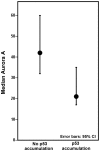TP53/p53 alterations and Aurora A expression in progressor and non-progressor colectomies from patients with longstanding ulcerative colitis
- PMID: 25333414
- PMCID: PMC4249752
- DOI: 10.3892/ijmm.2014.1974
TP53/p53 alterations and Aurora A expression in progressor and non-progressor colectomies from patients with longstanding ulcerative colitis
Abstract
Aneuploidy is a common feature in the colonic mucosa of patients suffering from the inflammatory bowel disease ulcerative colitis (UC) and often precedes the development of dysplasia and cancer. Aneuploidy is assumed to be caused by missegregation of chromosomes during mitosis, often due to a faulty spindle assembly checkpoint. p53 is a tumour suppressor protein known to regulate the spindle assembly checkpoint and is frequently mutated in aneuploid cells. Aurora A is a presumed oncoprotein, also involved in regulation of the spindle assembly checkpoint. In the present study, we examined the mutational frequency of TP53 and the protein levels of p53 in a set of 20 progressor and 10 non-progressor colectomies from patients suffering from longstanding UC. In addition, we re-examined previously published immunohistochemical data on Aurora A expression using the same material. Levels of Aurora A were re-examined with regard to DNA ploidy status and dysplasia within the progressors, as well as in relation to p53 accumulation and TP53 mutational status. We detected p53 accumulation only within the progressor colectomies, where it could be followed back 14 years prior to the colectomies, in pre-colectomy biopsies. TP53 mutations were detected in both progressors and non-progressors. Expression levels of Aurora A were similar in the progressors and non-progressors. Within the group of progressors however, low levels of Aurora A were associated with areas of DNA aneuploidy, as well as with increasing degrees of dysplasia. Our results indicate that alterations in p53 may be an early biomarker of a progressor colon, and that p53 is accumulated early in UC-related carcinogenesis. Furthermore, a decreased Aurora A expression is associated with the development of DNA aneuploidy, as well as with dysplasia in UC progressors.
Figures




Similar articles
-
Reduced hTERT protein levels are associated with DNA aneuploidy in the colonic mucosa of patients suffering from longstanding ulcerative colitis.Int J Mol Med. 2014 Jun;33(6):1477-83. doi: 10.3892/ijmm.2014.1708. Epub 2014 Mar 20. Int J Mol Med. 2014. PMID: 24676865 Free PMC article.
-
Spindle proteins Aurora A and BUB1B, but not Mad2, are aberrantly expressed in dysplastic mucosa of patients with longstanding ulcerative colitis.J Clin Pathol. 2007 Dec;60(12):1403-8. doi: 10.1136/jcp.2006.044305. Epub 2007 Feb 23. J Clin Pathol. 2007. PMID: 17322345 Free PMC article.
-
Usefulness of analysis of p53 alteration and observation of surface microstructure for diagnosis of ulcerative colitis-associated colorectal neoplasia.J Exp Clin Cancer Res. 2003 Mar;22(1):107-15. J Exp Clin Cancer Res. 2003. PMID: 12725330
-
p53 Expression as a Diagnostic Biomarker in Ulcerative Colitis-Associated Cancer.Int J Mol Sci. 2017 Jun 16;18(6):1284. doi: 10.3390/ijms18061284. Int J Mol Sci. 2017. PMID: 28621756 Free PMC article. Review.
-
Abnormal DNA content as a biomarker of large bowel cancer risk and prognosis.J Cell Biochem Suppl. 1992;16G:143-50. doi: 10.1002/jcb.240501125. J Cell Biochem Suppl. 1992. PMID: 1469894 Review.
Cited by
-
Exploration of the Potential Mechanisms of Wumei Pill for the Treatment of Ulcerative Colitis by Network Pharmacology.Gastroenterol Res Pract. 2021 Dec 21;2021:4227668. doi: 10.1155/2021/4227668. eCollection 2021. Gastroenterol Res Pract. 2021. PMID: 34970312 Free PMC article.
-
How does inflammation drive mutagenesis in colorectal cancer?Trends Cancer Res. 2017;12:111-132. Trends Cancer Res. 2017. PMID: 30147278 Free PMC article.
-
KRAS and TP53 mutations in inflammatory bowel disease-associated colorectal cancer: a meta-analysis.Oncotarget. 2017 Mar 28;8(13):22175-22186. doi: 10.18632/oncotarget.14549. Oncotarget. 2017. PMID: 28077799 Free PMC article. Review.
-
Analysis of the Efficacy and Pharmacological Mechanisms of Action of Zhenren Yangzang Decoction on Ulcerative Colitis Using Meta-Analysis and Network Pharmacology.Evid Based Complement Alternat Med. 2021 Dec 28;2021:4512755. doi: 10.1155/2021/4512755. eCollection 2021. Evid Based Complement Alternat Med. 2021. PMID: 34992665 Free PMC article.
References
-
- Rubin CE, Haggitt RC, Burmer GC, et al. DNA aneuploidy in colonic biopsies predicts future development of dysplasia in ulcerative colitis. Gastroenterology. 1992;103:1611–1620. - PubMed
-
- Rabinovitch PS, Dziadon S, Brentnall TA, et al. Pancolonic chromosomal instability precedes dysplasia and cancer in ulcerative colitis. Cancer Res. 1999;59:5148–5153. - PubMed
Publication types
MeSH terms
Substances
LinkOut - more resources
Full Text Sources
Other Literature Sources
Medical
Research Materials
Miscellaneous

